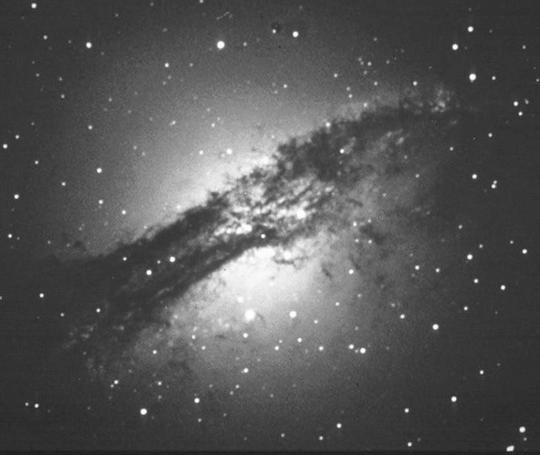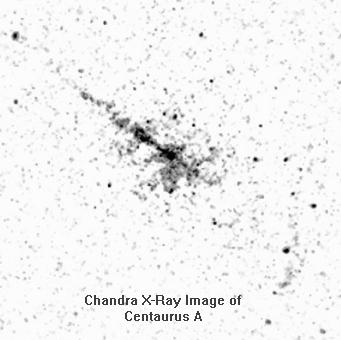Centaurus A
Jack Kramer
At a distance of eleven million light years from Earth, Centaurus A has been a favorite target of astronomers because it is the nearest example of a class of objects called active galaxies. These galaxies are noted for their explosive activity, which is presumed to be due to a supermassive black hole in their centers.
Centaurus A (NGC 5128) has long been a favorite with amateur astronomers too, because it appears through our telescopes pretty much as it appears in photographs. This is because it is a bright object at magnitude 6.8 and the details are sharply defined. The central absorption band shows up very well even in modest telescopes. Now the bad news: at a declination of -43o, it lies so close to our horizon in northern Illinois that not many amateurs up here have spotted it. Your horizon must be extremely low and the atmosphere must be absolutely clear. A few LCAS folk have tried it, with no luck as far as I know. But several of us have seen it easily during our many observing trips to New Mexico. In fact, it has become a "must see" during our springtime treks to the Southwest.

In October 1999, NASA's Chandra X-ray Observatory acquired an extraordinary image of Centaurus, which shows X-ray jets erupting from the center of the galaxy over a distance of 25,000 light years. Also detected are a group of X-ray sources clustered around the nucleus, which is believed to harbor a supermassive black hole. Analysis of these sources may provide information about how the galaxy and the black hole in the center were formed. One of the most intriguing features of supermassive black holes is that they do not suck up all the matter that falls within their sphere of influence. While some of the matter falls toward the black hole, other matter explodes away from the black hole in high-energy jets that move at near the speed of light. The presence of bright X-ray jets in the Chandra image means that electric fields are continually accelerating electrons to extremely high energies over enormous distances. Exactly how this happens remains a major puzzle.
Astronomers have evidence obtained with optical and infrared telescopes that Centaurus A collided with a small spiral galaxy several hundred million years ago. This collision is believed to have triggered a burst of star formation and supplied gas to fuel the activity of the central black hole. The X-ray jets and the cluster of sources may be the byproduct of that collision.

In the picture above, two x-ray jets are shown extending from a galactic center thought to be home to a huge black hole. The brilliant jet visible in the x-ray is perpendicular to the apparent plane of the galaxy shown in the visible light photo to the left. The Chandra X-ray image of Centaurus A shows a bright source in the nucleus of the galaxy at the location of the suspected supermassive black hole. The bright jet extending out from the nucleus to the upper left is due to explosive activity around the black hole that ejects matter at high speeds from the vicinity of the black hole. A "counter jet" extending to the lower right can also be seen. This jet is probably pointing away from us, which accounts for its faint appearance.
The length and shape of the X-ray jet pinned down the source of the radiation: extremely high-energy electrons spiraling around a magnetic field produce the X-ray emission. The entire length of the X-ray jet is comparable to the diameter of the Milky Way Galaxy!
Chandra data c/o NASA Marshall Space Flight Center
Published in the April 2000 issue of the NightTimes




